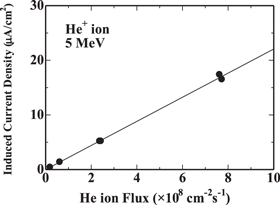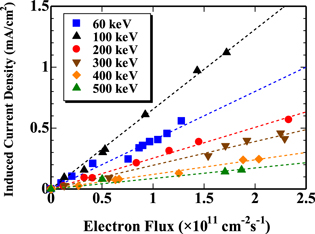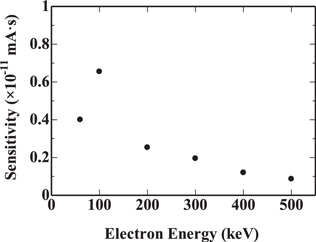Abstract
In this work, the effects of He ion and electron beam irradiation on substrate-type CdTe solar cells that are suitable for the detection of alpha and beta radiation are investigated. He ion irradiation revealed that the induced current proportionally increased with the increase of He ion current and that it is possible to detect alpha radiation using a substrate-type CdTe solar cell dosimeter. Next, the electron irradiation effects were investigated. The induced current proportional to the electron flux was also observed, and the sensitivity depended on the electron energy. In addition, the degradation of a substrate-type CdTe solar cell dosimeter by electron beam irradiation was investigated. No significant degradation in short-circuit current was observed at the electron irradiation of 3 × 1016 cm−2 at 200 keV and 1 × 1016 cm−2 at 400 keV. This result suggests that the substrate-type CdTe solar cell dosimeter is sufficiently resistant to electron irradiation.
Export citation and abstract BibTeX RIS
1. Introduction
The radiation environment inside the reactors and buildings of the Fukushima Daiichi nuclear power station is extremely high due to the accident, and there is a need to develop high-dose-rate radiation measurement technology based on the needs of the work environment. Radiation measurement systems for decommissioning work require dosimetry under a high dose rate, without the necessity of a power supply, ultra-small size, lightweight, and high radiation tolerance. Near the reactor pressure vessel (RPV), measurement of high-dose rates of several Gy h−1 to 1 kGy h−1 are required. 1) In addition, because the detector must be inserted through a small hole of approximately 10 cm in diameter, it is important to reduce the size of the measurement device. The only conventional detector that is compact and capable of measuring high-dose rates is an ionization chamber, but because hydrogen is expected to remain in the vicinity of the RPV, fire is strictly prohibited, and the detector must be powerless. Therefore, we have proposed a radiation measurement system based on dosimetry technology using a solar cell. 2–4) Solar cells have structures similar to those of semiconductor radiation detectors. Conventional semiconductor radiation detectors have relatively thick structures because the absorption coefficient of radiation is much smaller than that of sunlight in semiconductors. On the other hand, solar cells, especially compound semiconductor thin-film solar cells, have a thin structure but are considered unsuitable for detecting high-dose rate radiation. In addition, the application of bias voltage is not required in solar cells because solar cells have an internal electric field in a p–n junction. Furthermore, the proposed dosimeter has the features of ultra-compactness, lightweight, and high radiation tolerance.
The polycrystalline CdTe thin-film solar cell is a promising candidate as a highly efficient and low-cost thin-film solar cell because it has a direct band gap of approximately 1.5 eV, which is almost the optimal band gap for non-concentrated single-junction solar cells, and also because large-area, high-quality polycrystalline CdTe films can be prepared by simple and easy methods such as close-spaced sublimation 5–13) and vapor transport deposition. 13–17) To date, the highest efficiency of a CdTe solar cell of 22.1% has been reported. 13,18) In addition, because CdTe is used in radiation detectors, we also expect CdTe solar cells to have a high tolerance to radiation. 19–28) In our previous work, we investigated the effects of γ-ray irradiation on conventional polycrystalline CdTe thin-film solar cells in superstrate configuration. 29) It was reported that the CdTe solar cell has sufficient tolerance against γ-ray exposure up to 3 MGy, and that γ-ray induced current density linearly increased with increasing γ-ray intensity in the range up to approximately 1.5 kGy h−1. 29)
Figure 1 shows cross-sectional structures of (a) a conventional superstrate-type CdTe solar cell and (b) a substrate-type CdTe solar cell on a carbon substrate. CdTe solar cells are conventionally fabricated in a superstrate configuration. On the other hand, solar cells in substrate configuration have several advantages as compared with conventional super-straight cells because the light is incident on the film side of the stack. For example, substrate-type CdTe solar cells offer the possibility of choosing a variety of substrate materials such as inexpensive substrates and lightweight, flexible substrates due to the nonnecessity of transparent superstrates. To date, we have investigated the effects of Cu doping on substrate-type CdTe solar cells on carbon substrates, and reported an efficiency of approximately 10%. 30) However, the conversion efficiencies of substrate-type CdTe solar cells 31–34) are lower than those of the conventional superstrate configuration. 18)
Fig. 1. Cross-sectional structures of (a) the conventional superstrate-type CdTe solar cell and (b) the substrate-type CdTe solar cell on carbon substrate.
Download figure:
Standard image High-resolution imageOn the other hand, for the detection of alpha and beta radiation, the substrate-type CdTe solar cell is suitable. In conventional superstrate-type CdTe solar cells, alpha and beta rays are considered to be attenuated in the glass substrate. On the other hand, the substrate-type CdTe solar cell can directly absorb the radiation. In this work, we investigated the effects of He ion and electron beam irradiation of substrate-type CdTe solar cells.
2. Experimental methods
In this work, we employed substrate-type polycrystalline CdTe thin-film solar cells with a carbon/CdTe/CdS/ZnO:Al/Ag structure as shown in Fig. 1(b). The CdTe solar cells were fabricated by the method reported in previous papers. 30) The thicknesses of the CdTe, CdS, and ZnO:Al layers were approximately 10 μm, 100 nm, and 300 nm, respectively. The area of the CdTe solar cells was approximately 0.6 cm2.
Singly ionized He atoms were irradiated using a tandem accelerator at the Takasaki Advanced Radiation Research Institute, National Institutes for Quantum and Radiological Science and Technology. The He ion beam accelerated by the tandem accelerator was transported through a vacuum pipe to the vacuum chamber for irradiation to the sample. The He ions were scanned by the scan coil to the size of 3 × 2 cm, and irradiated uniformly over the entire area of the sample. To measure the induced current of the solar cells during irradiation, a probe was placed on the solar cell and the current signal was extracted from the introduction terminal located on the side of the irradiation chamber. The radiation-induced currents of the solar cells were measured in the vacuum chamber. The He ion flux incident on the solar cell was measured using a Faraday cup before and after irradiation.
Electron irradiation effects were investigated by using the Cockcroft–Walton (CW) electron accelerator at the Radiation Research Center of Osaka Metropolitan University. The energy of the electron irradiation was varied in the range of 60–500 keV. An electron beam generated by the CW electron accelerator was transported through a vacuum pipe to the vacuum chamber for irradiation to the sample. The electron beam was uniformly irradiated over the entire area of the sample stage by scanning coils. The scan speed was 499 Hz in the vertical direction and 1000 Hz in the horizontal direction. Electron flux incident on the solar cell during the tests was measured using a Faraday cup at just the side of the sample. The probes were installed on the sample stage and also placed on the front and rear electrodes of the solar cell with the two-terminal method. The current signal was extracted from the introduction terminal located in the irradiation chamber. A rise in the temperature of the sample due to electron irradiation was prevented by a cooling system. For investigating the degradation due to electron beam irradiation, current–voltage (I–V) characteristics of the cell were measured under simulated solar light (AM 1.5, 100 mW cm−2) after reaching each electron fluence in the vacuum chamber at the temperature of 25 °C.
Furthermore, the analysis of the deposition energy of electron beam sensitivity for the substrate-type CdTe solar cell was performed by the Particle and Heavy Ion Transport code System (PHITS) (version 3.10). 35)
3. Results and discussion
3.1. He-ion-induced current of substrate-type CdTe solar cell
First, He ion irradiation was performed to investigate the effect of alpha radiation on the substrate-type CdTe solar cell. Figure 2 shows the dependence of the induced current density of the substrate-type CdTe solar cell on He ion flux. The energy of the He ions was set to 5 MeV, which is a typical value for alpha particles from nuclear fuel. The conversion efficiency of the cell was 5.6% (Voc: 0.595 V, Jsc: 17.8 mA cm−2, F.F.: 0.559). It is considered that radiation detection sensitivity is related to short-circuit current density (Jsc) in order to operate at zero bias. The induced current proportionally increases with the increase of He ion flux. This result indicates that the induced current is proportional to the α-ray dose rate, and that it is possible to detect α-rays using substrate-type CdTe solar cells by clarifying the relationship between the induced current and radiation dose rate in advance.
Fig. 2. Dependence of induced current density of the substrate-type CdTe solar cell on He ion flux.
Download figure:
Standard image High-resolution image3.2. Electron-beam-induced current of a substrate-type CdTe solar cell
Next, we evaluated the electron-beam-induced current of a substrate-type CdTe solar cell with various electron beam energies to investigate the β-ray detection by CdTe solar cells. Figure 3 shows the relationship between the electron flux and the induced current. The conversion efficiency of the cell was 2.3% (Voc: 0.629 V, Jsc: 12.5 mA cm−2, F.F.: 0.296). At each electron beam energy, the induced current is proportional to the electron flux. This result indicates that it is possible to detect beta radiation using the substrate-type CdTe solar cell dosimeter. In addition, it was found that the sensitivity depended on the electron beam energy. Figure 4 shows the dependence of the sensitivity on the electron beam energy, calculated from Fig. 3. The sensitivity increased with increasing electron energy up to 100 keV, and decreased above 100 keV. To investigate the mechanism of the electron beam energy dependence, the electron sensitivity of the substrate-type CdTe solar cell was simulated by PHITS. 26) Figure 5 shows the dependence of the sensitivity on the electron beam energy simulated by PHITS. Simulations using PHITS showed that the electron sensitivity of the substrate-type CdTe solar cell decreased with increasing the electron beam energy. As the electron beam energy increases, the depth of the penetration of the electron beam increases and absorption in the range of the carrier collection lengths decreases, which may have reduced sensitivity. On the other hand, at the electron energy of 60 keV, sensitivity is low compared with 100 keV. This result cannot be explained by a decrease in absorption in the range of the carrier collection lengths. We speculated that the decrease in the sensitivity at 60 keV was due to shielding by the Ag electrode, ZnO, and CdS layers and/or the carrier recombination in the ZnO layer, CdS layer, and CdS/CdTe interface on the surface side. It was considered that the electron sensitivity increased with increasing the electron beam energy in the range below 100 keV because the effects of shielding and recombination in the surface region were relatively smaller for higher electron beam energies due to the increase in the penetration depth of the electrons.
Fig. 3. (Color online) Relationship between the electron flux and the induced current.
Download figure:
Standard image High-resolution imageFig. 4. Dependence of sensitivity on electron beam energy, calculated from Fig. 3.
Download figure:
Standard image High-resolution imageFig. 5. Dependence of sensitivity on electron beam energy simulated by PHITS.
Download figure:
Standard image High-resolution image3.3. Electron beam tolerance of the CdTe solar cell
Next, we investigated the degradation of the substrate-type CdTe solar cells due to electron irradiation. First, electrons were irradiated at 200 keV to an electron fluence of 3 × 1016 cm−2, followed by irradiation to 1 × 1016 cm−2 at 400 keV. Figure 6 shows the solar cell parameters for a substrate-type CdTe solar cell as a function of electron fluence. The open-circuit voltage (Voc) and fill factor decreased in the range of 3 × 1014 to 3 × 1015 cm−2 at 200 keV, recovered with further increase in the electron fluence. The open-circuit voltage recovered to a larger value than before electron irradiation. It was reported that Cu(In,Ga)Se2 (CIGS) solar cells were not degraded by electron irradiation at 250 keV and that the increase in carrier concentration, which was caused by the defects generated by the electron irradiation suppressed rollover. 36) Moreover, we reported that in superstrate-type CdTe solar cells, gamma irradiation initially lowered the fill factor, and that it was recovered due to the rollover suppression after further gamma irradiation. 22) However, no rollover suppression was observed with electron-beam irradiation of the substrate-type CdTe solar cells. Figure 7 shows the I–V characteristics of the substrate-type CdTe solar cell before and after the electron beam irradiation. It was found that the leakage current increased due to the decrease in shunt resistance in the I–V characteristic after the electron beam irradiation of 1 × 1015 cm−2 at 200 keV, and that electron irradiation reduced leakage current but did not suppress rollover after the electron beam irradiation of 3 × 1016 cm−2 at 200 keV. The shunt resistances shown in Figs. 7(a)–7(d) were estimated as approximately 350, 70, 260, and 220 Ω cm2, respectively. Therefore, the recovery due to electron irradiation cannot be explained by the increase in carrier concentration. It was reported that improvement in conversion efficiency was observed in the early stages of irradiation of proton with the energy in the range of 650 keV to 2.2 MeV to the CdTe solar cell, and that the improvement in conversion efficiency was caused by passivation of recombination centers. 37) Furthermore, according to the reported non-ionization energy loss of CdTe, 37) displacement damage was estimated to be small for electron irradiation with energies below 400 keV. We speculated that electron irradiation of CdTe solar cells produced defects that reduced shunt resistance by mechanisms excluding displacement damage, and that the improvement in shunt resistance by further electron irradiation was probably due to defect passivation. On the other hand, little degradation was observed in the short-circuit current density (Jsc). Considering that solar cell dosimeters are used at zero bias, substrate-type CdTe solar cells were found to be sufficiently resistant to electron irradiation.
Fig. 6. Solar cell parameters for the substrate-type CdTe solar cell as a function of the electron fluence. Voc, Jsc, and F.F. denote open-circuit voltage, short-circuit current density, and fill factor, respectively.
Download figure:
Standard image High-resolution imageFig. 7. (Color online) I–V characteristics of the substrate-type CdTe solar cell (a) before and after the electron beam irradiation of (b) 1 × 1015 cm−2 at 200 keV, (c) 3 × 1016 cm−2 at 200 keV, and (d) 3 × 1016 cm−2 at 200 keV and 1 × 1016 cm−2 at 400 keV.
Download figure:
Standard image High-resolution image4. Conclusions
In conventional superstrate-type CdTe solar cells, alpha and beta rays are considered to be attenuated in the glass substrate. On the other hand, the substrate-type CdTe solar cell can directly absorb the radiation. Therefore, for the detection of alpha and beta radiation, the substrate-type CdTe solar cell is suitable. In this work, we investigated the effects of He ion and electron beam irradiation on substrate-type CdTe solar cells. He ions were irradiated at the energy of 5 MeV, which is the typical value for alpha particles from nuclear fuel. It was found that the induced current proportionally increased with the increase of He ion current and that it is possible to detect alpha radiation using a substrate-type CdTe solar cell dosimeter. Next, we investigated the electron irradiation effects. The induced current proportional to the electron flux was also observed, and the sensitivity depended on the electron energy. In addition, the degradation of a substrate-type CdTe solar cell dosimeter by electron beam irradiation was investigated. Furthermore, no significant degradation in short-circuit current Jsc was observed by the electron irradiation of 3 × 1016 cm−2 at 200 keV and 1 × 1016 cm−2 at 400 keV. This result suggests that the substrate-type CdTe solar cell dosimeter is sufficiently resistant to electron irradiation.
Acknowledgments
This work was supported by JAEA Nuclear Energy S&T and Human Resource Development Project through concentrating wisdom Grant Numbers JPJA18B18072113 and JPJA22P22683601.








